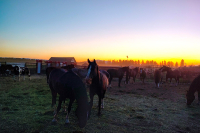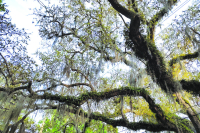International Festival Day brings dancing, demonstrations
Folkmoot’s International Festival Day will be held from 10 a.m. until 5 p.m. on Saturday, July 30, in Waynesville. The festival features a huge juried craft show, international cuisine, Folkmoot USA performances, regional music and dance and the Passport to the Arts Children’s area.
Expect about 25,000 in downtown Waynesville, so prepare for the crowd if you plan to attend.
Demonstrations such as flame workers, potters and woodworkers will be available. The Passport to the Arts Children’s Area takes children on a trip around the world in the United Community Bank parking lot. The children make rain sticks, abstract inkblots, fiesta headdresses, finger knitting, and origami crafts to take home.
Festival entertainment is provided by Folkmoot USA’s international dancers and musicians, the Smoky Mountain Stompers, students from the Haywood County Arts Council’s Junior Appalachians Musicians program and more.
Entertainment will begin at 10:15 a.m. and performers move along the street with impromptu performances throughout the day.
828.452.0593 or visit www.haywoodarts.org.
Making a joyful noise
In 1984, Flora Gammon agreed to a favor for a colleague and friend, Dr. Clinton Border. He needed her musical expertise for a new festival he was starting called Folkmoot USA. She didn’t know it then, but that favor for a friend would touch off a 27-year relationship with the event and leave ripples of her influence across two-and-a-half decades of Folkmoot history.
Today, Gammon directs the international band, an ensemble made of the musicians who perform in the festival. She also emcees when needed and does various other volunteer duties as a member of the Folkmoot Board of Directors.
But that first year, she took up the daunting task of arranging an interfaith service for festival-goers and participants.
It wasn’t an assignment altogether out of her range; she was then assistant director of music at the Grandfather Mountain Highland Games, where her mother had long been director. But convincing each cadre of performers, with their separate religions and traditions and language barriers, was a challenge.
The Turkish contingency — a gruff group of men with swords — proved her biggest hurdle.
“The director of the group spoke not one word of English, and I had to sit there and try to get them to understand what we were doing and try to get them to be a part of it,” says Gammon. But in the end, she succeeded. And thus began her career as a kind of cultural liaison with the festival.
It’s just such stories and experiences that Gammon seems to cherish most from her long involvement in the American incarnation of Folkmoot.
She kept directing the interfaith service until it was dropped a few years after the festival’s inception. And when the founder of the international band, Dr. Eva Adcock, died and left the conductor’s baton untended, Gammon took it up.
She started with the group in 1995, and she’s been directing the impromptu folk orchestra ever since. Each year, it’s a surprise what instruments will show up and who will already know the music. Some musicians, she has learned, read music, while some reject it outright, playing solely by ear.
Some will come with conventional symphonic instruments, while some will bring ancient and traditional folk music-makers found in few symphonies.
But, she says, they always make it work.
“They’ve never played music together, and I bring them together and in about 30 minutes we have a band,” says Gammon.
The band plays four songs, and performs at the opening gala, the opening parade and then again at the closing ceremony. They rehearse only once.
Gammon says the lack of rehearsal and mixture of seemingly disparate instruments has never been a problem.
“We have a combination of some totally folk-style instruments and some concert instruments. We have a combination, but at the same time it works, you know. Because even those who come from the countries where they’re playing more classical-type instruments, they’re still playing folk music,” says Gammon.
Gradually, the band has added to its repertoire and increased the number of musicians who return, music in hand, from years past. In 2005, they started playing the Folkmoot USA theme, which had, until then, been played on cassettes that were threatening to wear out.
“I was very pleased to start having them play the theme song,” says Gammon. “We do not allow canned music, but here we were using taped music, and that embarrassed me.”
And as the band and its role have grown and matured with the festival, so has Gammon.
In her first two years with the band, she convinced Dick Trevarthen, a musician and music professor, to do the actual, baton-in-hand direction. She was a singer, mostly, and had no experience whatsoever conducting a band.
“He did it for two years and then said, ‘Here, you can do it.’ He gave me two signals to use, and I said, ‘Well, that’s easy,’” said Gammon. “Though the second year I did it I forgot what ‘stop’ was.”
That was also the year she learned that a finger across the throat was, apparently, a universal sign for ‘cut the music.’
Her fake-it-to-make-it technique was successful, though. Gammon fondly recalls the memory of a Soviet orchestral conductor unexpectedly approaching her after a performance. Expecting a complaint, she was bracing herself when the woman, in a harsh Russian accent, complimented her directing skills. She jokes that, because of this, she’s nicknamed herself Folkmoot’s Great Impostor.
But after 16 years with the band, she is an impostor no longer, having earned the baton that’s directed hundreds of musicians over the years.
For Gammon, and the musicians she leads, the international band, just like the festival itself, is about the people that comprise it, and recognizing their unique talents.
“It’s giving the musicians an outlet, because we’re mainly a folk dance festival, and so the emphasis is often on the dancers. These are professional musicians that come over here and they are thrown in the background,” says Gammon. This gives them a chance, however brief, to shine.
And whether through Turkish swordsmen, Russian directors or reticent Basques being coaxed into a round of the hokey pokey, it’s clear that Gammon has made her mark on Folkmoot. And it, in turn, has made a mark on her and her indefatigable spirit.
“You get people together and you look them in the eye and you smile and you can do anything you need to do,” said Gammon.
That’s a motto you can probably find her living by, smile on her face, this summer, in front of the international band once more.
Folkmoot Hymn
Used at candlelight closing • Words and Music: R.R. Trevarthan
Folkmoot is friendship, Folkmoot is peace;
Folkmoot is harmony, and Folkmoot is love.
For it is friendship, and it is peace;
And it is harmony, that gives us love.
Friendship, Peace, Harmony and Love.
Come Dance, Come Sing
The Folkmoot Theme Song
Words and Music: John Pollard • Come dance, come sing;
Come meet the world as it flies on the wing.
Come laugh, come cry;
Come meet the people, they’re passing you by.
We’re coming together, folk of the world;
Meeting in friendship, the flags to unfurl.
Brothers in dancing, we’re here for today,
At Folkmoot USA.
The groups of Folkmoot 2011
Batimbo Drummers Ensemble
The Republic of Burundi in central Africa has always been known for its hypnotic drum music, and field recordings of Burundi drumming have entranced listeners for years. Those drum rhythms have also been incorporated into world-fusion music anytime some intense percussion is called for.
The Batimbo Drummers Ensemble retain the responsibility and privilege of making, beating and keeping the drums. Until recently, the drums could only be beaten in homage to the king or to his ancestors. Today their tradition is gradually losing its ritual symbolism to become more of an art reserved for festivals.
The master drummer’s ensemble, dressed in draped robes of green, red, and white, are composed of drums arranged in a circular arc. The drums to the left — “amashakwe” — provide the continuous rhythm, while those on the right — “Ibishikizo” — follow the rhythm given by the soloist (placed in the center of the semi-circle in front of the others). The performers are in constant interplay with the audience and each drummer may spontaneously leave his drum, take his place in the center of the arc, and dance. In some performances drummers may leap over their drums or place the drums on their heads while playing or dancing.
Strathcona Chinese Dance Company
Strathcona Chinese Dance Company (SCDC), which is affiliated with the Vancouver Academy of Dance, was founded in 1973 by Maria Mimie Ho as a recreational dance program to promote Chinese dance in Canada.
The company derives its name from the Strathcona section of the city of Vancouver, in British Columbia, Canada. Since its inception, the company has grown into a world-renowned dance troupe, performing for many heads of state and dignitaries. SCDC is committed to fostering artistic exchange and enhancing cultural understanding while promoting goodwill and fellowship through the performing arts.
The troupe’s large catalog of traditional Chinese dance includes “The Red Ribbon Dance,” “Flying Kites” and “Peach Blossoms.”
The company last visited Folkmoot 19 years ago in 1992.
Klek of Croatia
Folklore ensemble Klek of Croatia was formed in 1980 with an emphasis on preserving and performing the folk customs of the Croatian and Ogulin cultures.
The group has more than 200 members includding two folklore ensembles, a seniors group, three children’s groups, a mens vocal group, a womens vocal group and a group of tambura players.
The tambura is a folk instrument similar to a lute or mandolin. The 40 members of the tambura group perform dances from cities and different regions in Croatia such as Ogulin, Bizovac, Baranja, Bratina, Split, Lika, Međimurje, Bilogora, Dubrovnik, Ražanac, Vrlika, Hvar and Bunjevac.
The group has more than 200 new and refurbished costumes.
The musicians perform dance tunes and compositions from famous composers.
Klek has performed in folk festivals all over Croatia in other countries such as Hungary, Turkey, France, Belgium, Portugal, Korea, Austria and Italy.
Tahdittomat dance troupe
The Tahdittomat dance troupe from Finland was founded in 1984
for the purpose of preserving traditional Finnish folk dancing.
The group’s aim is to promote traditional Finnish culture throughout the world with activities ranging from dance studies to performances and excursions.
Tahdittomat’s home is in the municipality of Jokionen in southern Finland. Villages in this region of Finland include Haapaniemi, Jokioinen, Lammi, and Latovainio, among others.
Tahdittomat is an ensemble cast of dancers and musicians that are both professionals and enthusiastic amateurs. They range in age from 17 to 40 and perform both in Finland and abroad. Tahdittomat present both complex allegorical dances, and also more playful fare, all driven by a common thread.
For example, the troupe often performs a dance entitled “Illatsut” which is told in the Karelian language. Karelia was a historical province of Finland which is now divided between Finland and Russia. “Illatsut’s” theme is that of youth and fellowship.
Viard Nouvelle
The Viard Nouvelle dance troupe from the Caribbean island of Guadeloupe has been in existence for 28 years. Since its inception, its leaders have tried to maintain tradition and provide young people an education and outlet through those traditions.
Among the dances and music performed by Viard Nouvelle is the Gwo ka, which translates to “Big drum.” Gwo ka is both a family of hand drums and the music created with them, which is a major part of Guadeloupian folk music. There are seven rhythms in gwo ka, which are embellished by the drummers. Different sizes of drums establish the foundation and its flourishes, with the largest, the boula, playing the central rhythm and the smaller, markeur drum interplays with the dancers, audience or singer.
Gwo ka singing is usually guttural, nasal and rough, though it can also be bright and smooth. It is accompanied by uplifting and complex harmonies and melodies. There are also dances that tell folk stories that are accompanied by the gwo ka drums.
Guadeloupians still use gwo ka drums in communal experiences called lewozes; this is the most traditional manifestation of gwo ka in modern Guadeloupe. Gwo ka is also played at Carnival and other celebrations. A modernized and popularized form of gwo ka is well-known on the islands; it is known as “gwo ka moderne.”
Figulinas Florinas
The group “Figulinas” — which translates into English as “fictile” — is an appropriate name for this group of talented dancers from the island of Sardinia in Italy.
Figulinas was born 23 years ago when young Sardinian performers with an interest and passion for reconstructing the traditional clothing and folk dances of Sardinia decided to form a group. The name is a play on words stemming from the fact that the area of Sardinia, from which the group hails, is world-renowned for its pottery.
The group is from the city of Sassari which is the second largest city in Sardinia. The characteristics of the group are based mainly in accordance with the canons of traditional Sardinian dance.
Diego Martin Footprints
The Diego Martin Footprints Folk Performers — who hail from the town of Diego Martin in northwestern Trinidad — have been in existence for more than 35 years.
The group represented Trinidad in Folkmoot in 2008 during the 25th anniversary year of the festival. In their own words, Footprints performers strive to, “Be the best we can be, keeping culture alive through dance.”
The most familiar musical tradition represented by the Footprints Folk Performers is Calypso music. Calypso originated as a form of communication between Afro-Caribbean slaves on the island when former slave masters forbid slaves from speaking to each other. A direct relative of Calypso and another specialty of Footprints is Soca, which combines percussion rhythms with Chutney music.
Also familiar to many audiences are the dances of Trinidad, which include the Limbo and Moko Jumbies. The Limbo, a derivative of the word “limber,” is a dance rooted in African history where a performer bends backwards while walking forward, under a pole. When a dancers body passes completely under the pole, it is said to be symbolic of the triumph of life over death. Moko Jumbies are stilt walkers that represent a dance tradition carried from Africa over the Atlantic to Trinidad.
American Racket Dance Company
American Racket Dance Company features American clogging and percussive dance.
American Racket was founded on UF (University of Florida) campus in 2002 by then-student Andy Howard. Since then, American Racket has built a global reputation for high-energy presentations.
American Racket is a guaranteed toe-tapping, hand-clapping good time for all and a celebration of what young adults are doing to revive and reinvent the dance culture of the United States.
Andy Howard founded SoundStage in 2001 while attending University of Florida; the original group comprised students and regional dancers specializing in clogging, tap and other forms of percussive dance. In 2007, the group relocated to Central Florida and adopted the name “American Racket,” originally the name of a performance organized and choreographed by Howard for the Orlando International Fringe Festival. Howard was inducted into the All-American Clogging Team in 2002.
American Racket has represented the United States as “cultural ambassadors” at international festivals sanctioned by C.I.O.F.F. (International Council of Organizations for Folklore Festivals) in Costa Rica, Brazil, and Canada.
A gourmet makeover for Folkmoot’s food
There are certain things that are nearly exclusive to cafeterias. Mystery meat. Square pizza. Chicken rings, presumably to go on chicken fingers.
Such foods and their compatriots — tater tots, anyone? — have long been the staples of institutional eating in America.
In recent years, there have been movements to bring some healthier, or at least more recognizable, selections onto lunch lines in schools, hospitals and the like. Think Jamie Oliver crusading against chocolate milk in the UK. Or Beyonce doing the dougie in a school cafeteria for Michelle Obama’s campaign against childhood obesity.
This year in Haywood County, there’s another cafeteria that’s hoping to take a few giant steps away from those stereotypes, as well.
Folkmoot USA, the international celebration of song and dance, serves 20,000 meals over about a two-week period, catering for dancers, musicians, staff members and volunteers. The devoted catering staff deliver four meals a day — that’s 52 in total if you’re counting — and this year, they’ll be taking their culinary cues from a new playbook.
“The idea is that local chefs come in and they can do something as simple as creating one dish to help train our cafeteria staff how to be flexible and creative and learn to work with what they have in the kitchen,” said Karen Babcock, the festival’s executive director.
The goal, said Babcock, is to make the meals local, nutritious, enticing and possibly even aspiring to gourmet. So, in addition to the kitchen workers, most of whom have experience in food service settings ranging from school cafeterias to more upscale eateries, she’s bringing in a couple of ringers to help them along.
Chris Hall, executive chef for the MedWest health care system, and Josh Monroe, chef and owner of The Chef’s Table in Waynesville, have signed on to assist in the effort.
It’s not that what they’ve been serving in festivals gone by was inedible. On the contrary, Babcock said in years past, Folkmoot’s performers have given the food positive reviews. But good can always be better, and not just in taste but in principle.
In recent years, festival organizers have connected with Buy Haywood, a program that supports local growers and encourages local buying. This year, Babcock estimated that about 50 percent of what is served will be fresh produce, most of it local.
That portion of the initiative started last year, when a salad bar and fresh fruit station made their way into the cafeteria. Now it’s growing to include the main courses, too.
When you’re serving meals on a large scale with little time, however, upping the nutrition and taste factors is a much greater challenge than it is on a restaurant level.
That’s where Chris Hall comes in. His role in the plan is to plan. He’s currently putting together menus that combine low cost, local ingredients, solid nutrition and great taste. It’s a challenging directive, but not a new one for Hall, who has worked at doing the same thing for cuisine that’s gotten a bad rap over the years: hospital food.
“It’s kind-of the last frontier in cooking,” said Hall. “If you can make hospital food taste good, you can make anything taste good.”
And the key isn’t spending more, it’s paying more attention to the process itself. Hall said he focuses on naturally flavorful foods and old-fashioned cooking techniques that create richer flavors with fewer additives.
That’s why Karen Babcock wanted to bring in experts like Hall and Monroe, who could help school her staff in techniques for better cooking.
“The idea sparked in my mind that we need some training, we need some folks that can teach about the science of how to make a good meal,” she said. “I thought, ‘it can’t be that hard to improve what we serve to these performers. They need nutrition, they need carbs, they need quality food to keep their engines running.’”
So while Hall will provide menu direction, Monroe is coming in to give on-the-line input for a few meals during the festival.
“It challenges how the things hold on the line,” said Monroe of the fresh food concept. That very problem is why you’re more likely to see processed food over farm-fresh offerings on buffet lines. Fresh is, by definition, a short-term state of being.
But, said Monroe, challenging is far from unattainable.
“It’s possible, you just have to know what you’re doing,” he said.
His plan is to make some trips to local markets, look at what’s available and devise some creative ways to incorporate that into Folkmoot’s mealtime offerings.
Plus, he’ll have some of his signature fruit carvings out at the fresh fruit station, which he hopes will be both appetizing and aesthetically pleasing. That’s part of the shift, too, towards better eating. As any foodie, or foodie reality show, will tell you, presentation is a key ingredient in a quality dish.
This new approach, said Babcock, isn’t meant to change the world, or the festival, overnight. It’s a staggered process that she hopes will, each year, make Folkmoot’s food better. Right now, she’s still welcoming chefs who would like to try their hand at one or two of this year’s meals.
She’s excited about the changes because they’re not just better for taste buds or waistlines, but they’re healthier for the festival’s books. Babcock said they’re saving a hefty sum by buying local, fresh food. And overall, she said, it’s about being good stewards of Folkmoot’s resources, good partners with their neighbors and good ambassadors to the performers who, for two weeks, call the brick building on Virginia Avenue their home.
“We’re trying to be socially responsible and responsible community members,” she said. “With Folkmoot being such a big consumer, we have a lot of opportunity to make a difference.”
Schedule of Events
Wednesday, July 27
1:00 pm Hazelwood Elementary School. Free Event.
2:00 pm Blue Ridge Community College, Bo Thomas Auditorium, Flat Rock. (6 Groups) Adults $25; Faculty, Students & Children (12 & under) 1/2 price.
7:30 pm Blue Ridge Community College, Bo Thomas Auditorium, Flat Rock. (6 Groups) Adults $25; Faculty, Students & Children (12 & under) 1/2 price.
7:30 pm Swain High School, Bryson City. (3 Groups) Adults $16; Children (12 & under) 1/2 price.
Thursday, July 28
7:30 pm Smoky Mtn. Center for Performing Arts, Franklin. (4 Groups) Adults $25, $20; Children (12 & under) $10.
7:30 pm Haywood Community College, Waynesville. (5 Groups) Reserved seating: $25, $20; General admission $15; Children (12 & under) 1/2 price.
Friday, July 29
2:00 pm Extravaganza Matinee, Stompin’ Ground, Maggie Valley. (7 Groups) Reserved seating: $25, $20; General admission $15; Children (12 & under) 1/2 price.
7:30 pm Extravaganza, Stompin’ Ground, Maggie Valley. (7 Groups) Reserved seating: $25, $20; General admission $15; Children (12 & under) 1/2 price.
Saturday, July 30
10-5 Haywood County Arts Council’s International Festival Day, Main Street, Waynesville. Free Event.
7:30 pm Haywood Community College, Clyde. (All Groups) Reserved seating: $30, $25; General admission $20; Children (12 & under) 1/2 price.
Sunday, July 31
7:00 pm Candlelight Closing, Stuart Auditorium, Lake Junaluska. (All Groups) Reserved seating: $30, $25; General admission $20; Children (12 & under) 1/2 price.
Leave politics at the door and enjoy Folkmoot USA
I’ve been volunteering with the Folkmoot USA International Dance Festival for about 15 years. It’s one of the most culturally rich, unique events in these mountains. It was going on before the Iron Curtain was raised, bringing dancers from those former communist countries to the U.S. for some eye-opening adventures.
Today, as terrorists lurk in shadowy places around the world and political divisions remain firmly entrenched, the message of this festival remains as strong as ever: people are more alike than they are different, and overcoming political and religious differences isn’t all that difficult when you focus on sharing instead of dividing. For the 28 years that Folkmoot has been in existence, politics has never won out over the sharing of traditions.
During the planning for many of the festivals in past years, some of us on the Folkmoot Board had nagging worries in the back of our minds that some countries would simply not get along. But it never happens, at least not for any kind of geopolitical reasons.
No, the worst we’ve had in 28 years are disagreements over who should do the finale, complaints about beds not being comfortable or rooms being too hot. Some of these are problems that have to be dealt with — and thank goodness for the Folkmoot staff — but these aren’t game-changers.
Folkmoot is an opportunity to forget politics and put xenophobic notions aside, and I would encourage everyone reading this to do just that and enjoy one of the performances happening in your community over the next week or so (July 22-31). You won’t be disappointed.
•••
I wrote a story for this year’s Folkmoot Guidebook about the history of the festival. While doing the research, I learned about an early attempt to bring Folkmoot under the tent of Bele Chere, Asheville’s huge street festival.
Charles Starnes, a former Tuscola High School principal and Folkmoot volunteer, was a close friend of Dr. Clint Border, who founded the festival. After Folkmoot’s first festival in 1984, it became very popular very quickly. Asheville’s own Bele Chere started in 1979, and was a small event compared to what it has become today.
Starnes told me — and Brenda O’Keefe of Joey’s Pancakes confirmed — that early on Bele Chere organizers contacted Folkmoot about bringing the festival to Asheville and running it in conjunction with Bele Chere. The idea was that the two festivals together could turn into something really big.
According to both Starnes and O’Keefe, Dr. Border was absolutely adamant that moving the festival to Asheville was not even open to discussion. Folkmoot, he said, would always be based in Haywood County. Twenty-eight years later, it is still here and is very successful.
As for Bele Chere, well, it did not need Folkmoot to thrive. It has become Asheville’s signature event and one of the largest street festivals in the country.
•••
And now for a little politics.
The current debate about debt and spending in the U.S. has highlighted a fundamental flaw of democracy: can people vote against their self-interest in the name of shared sacrifice?
As democracies across Europe — Ireland, Portugal, Greece, and now Italy — teeter on the verge of insolvency, governments are struggling to find a middle ground. Those on opposing sides of the political divides are whipping up their constituents, just like here in the U.S.
Many people have seen this coming and been writing about it for years. We have created social welfare programs — Medicare, Medicaid and Social Security — that have become very expensive. The senior citizens who get those benefits aren’t about to support cuts. Military spending here is huge, but those states and communities who depend on military bases don’t want them downsized or closed. The wealthy don’t want to pay more taxes, but they are the ones who can afford it. And on and on.
To fix these problems, I have to vote for leaders who will vote against my self-interest. So do you. The big question is whether any democracy can take this step, where the majority votes against what will benefit them in the short run.
(Scott McLeod can be reached at This email address is being protected from spambots. You need JavaScript enabled to view it..)
Folkmoot, Evergreen Packaging form multiyear partnership
Folkmoot USA, North Carolina’s Official International Festival, has locked down its first presenting sponsor.
Evergreen Packaging has partnered with the Festival as its presenting sponsor for 2010 through 2013, becoming the first international corporation to develop a multiyear relationship with the nonprofit.
Based in Waynesville, Folkmoot USA operates a two-week folklore festival hosting approximately 350 musicians and traditional dancers from all over the world.
“This means a lot to the festival,” said Folkmoot USA Executive Director Karen Babcock. “In tough economic times, it’s good to have someone step up and make a multiyear commitment.”
Revenues from ticket sales do not cover the costs associated with hosting the festival. The nonprofit must pay Folkmoot performers’ room, board, and transportation expenses, as well as cover the cost of renting performance venues.
Evergreen Packaging, with facilities in Canton and Waynesville, employs more than a thousand people in Haywood County, home to Folkmoot USA. Evergreen produces paper and packaging products in operations worldwide.
“The fact that we are an international company made sponsoring this festival a particularly good fit,” said Jody Hanks, Evergreen vice president and general counsel. “We’re looking forward to helping bring people from all over the world to experience being in Western North Carolina.”
The 2010 Folkmoot Festival will take place July 22 – August 1 throughout ten counties in Western North Carolina. Folkmoot has been presented annually longer than any other traditional international folk festival in the U.S. and is considered one of the best festivals of its kind in all of North America.
Grand Opening and Candlelight Closing Tickets are now on sale. Call 828.452.2997 or email This email address is being protected from spambots. You need JavaScript enabled to view it. for tickets.
For more information, visit www.FolkmootUSA.org or call 877.FolkUSA.
Leading the way: Folkmoot guides are instrumental in making sure group’s visits run smoothly
By Marian Larson • Contributing Writer
They are part camp counselor, part dorm parent, and part U.N. ambassador.
As Folkmoot arrives in Waynesville this week, the visiting dancers must somehow orient to their temporary American life in the mountains. Someone must help them manage their strict daily routine and orchestrate the elements of their day from meal to shower to performance.
Dance festival has gathered a crowd of supporters over the years
By Marian Larson • Contributing Writer
Not even a broken limb could keep one die-hard fan from missing a Folkmoot performance.
But then, “Folkmoot-fanaticism” seems to run in Karen Ford’s family.
Cooper wraps up first year as Folkmoot director
By Sarah Kucharski • Staff Writer
The 2006 Folkmoot USA international dance festival marks an important first for new executive director Jamye Cooper. This year will be the first year that she has organized the festival from start to finish, and thereby the first real test of her skills.













